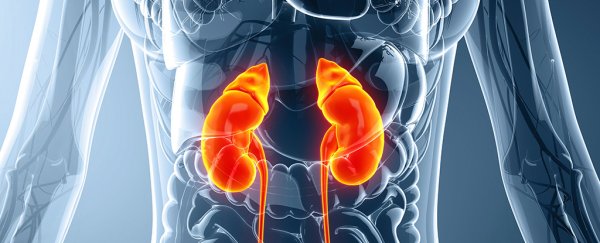
Researchers Just Found That Kidneys Act on Blood Differently Than We Thought Before
MIKE MCRAE
20 MAY 2022
By this time tomorrow, every drop of blood in your body will have passed through your kidneys dozens of times. With each pass, water saturated with waste is removed to form urine, and freshly cleaned blood then returns back into circulation.
We might imagine this vital task as a kind of force-fed filtration driven by the thumping pressures of our heartbeat. But, according to a new study co-authored by Johns Hopkins mechanical engineer Sean Sun, that description isn't quite as accurate as once thought.
"Everyone hears that kidneys filter blood, but conceptually that is incorrect," says Sun.
"What we showed is that kidney cells are pumps, not filters, and they are generating forces."
It's not for lack of looking that we happened to miss this peculiar mechanical activity, either. Anatomists have known about the kidney's structure and its role in producing urine from blood since the 17th century.
The organ's ability to mix passive physics of osmosis with active shunting of various chemicals in order to balance our body's salts, wastes, and water has also been extensively studied inside and outside of the body.
Yet each kidney consists of kilometers of channels and tubules crammed into a space no bigger than your fist, potentially making for some weird plumbing deep inside.
Studies have shown that the cells lining those tubules can sense changes in hydrostatic pressure, and even respond; however, it's not clear how or even whether those changes push back in some way.
Working out how fluids swish through those itty-bitty pipes isn't easy, either. Any experiment to study the hydraulics at work inside individual tubules would need some pretty impressive technology to screen out stray forces.
Which is precisely what Sun and colleagues from across the US came up with. Their micro-fluidic kidney pump (MFKP) consists of patterned blocks and porous membranes capable of containing a culture of cells that line kidney tubules.
Once the cells had settled into place and were subjected to a range of tests for electrical resistance and permeability, the researchers measured variations in pressure across the tissue in response to squirts of fluid from a syringe.
They noticed the movement of fluids near the cells dropped in accordance with a rise in hydraulic pressure, which was greater towards one end of the tissue than the other. Just as we'd expect if the tubules acted like a pump.
A close look at the proteins the cells were churning out revealed that small changes in the pressure of fluids entering the tissues changed the arrangements of ion channels and its supporting structure, altering its shape and function.
For most of us, this means fluids passing from the blood into the kidney's network of tubules moves in part under the mechanical direction of the cells themselves, adding a subtle new layer of operation that could help to explain a range of renal disorders.
To see how this behavior unfolds inside less-functional kidneys, the researchers used cells taken from individuals with the renal disorder autosomal dominant polycystic kidney disease, or ADPKD.
In this condition, thanks to the way the cells lining the kidney tubules change shape, cysts commonly form, distorting the tissue and raising the risk of kidney stones and urinary tract infections. But, according to the team's work, there's more to the story. The researchers observed the cells pumping in reverse, with the pressure gradient flipped from one end to the other.
When the FDA-approved ADPKD treatment tolvaptan was applied to the cells, their pressure gradients smoothed out, suggesting the drug works by reducing stress on the tissues and thereby slowing the rate at which cysts might form.
With this in mind, it's possible other tissues might also have their own versions of a mechanical pumping system adjusting fluid pressures at their convenience. Sun and his team aim to modify their device to test other tissues and organs.
This research was published in Nature Communications.
https://www.sciencealert.com/amazing-discovery-that-the-kidney-acts-like-a-pump-to-keep-our-blood-clean
Thanks to: https://www.sciencealert.com






 Sat Mar 23, 2024 11:33 pm by globalturbo
Sat Mar 23, 2024 11:33 pm by globalturbo

